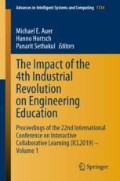Abstract
The purposes of this study were: (1) to develop Engineering Project-Based Learning Model Using Virtual Laboratory mix Augmented Reality to Enhance Engineering and Innovation Skills (2) to evaluate about the suitability of Engineering Project-Based Learning Model Using Virtual Laboratory mix Augmented Reality to Enhance Engineering and Innovation Skills by 3 education experts, 3 electrical communication engineering experts and 3 information technology and communication experts. The findings indicated that the Engineering Project-Based Learning Model Using Virtual Laboratory mix Augmented Reality to Enhance Engineering and Innovation Skills 4 Components: 1. Input with 5 steps: (1) Lesson objective (2) learner analysis (3) teacher analysis (4) content and (5) virtual laboratory, 2. Process have 5 steps: (1) problem identification and analysis (2) project definition (3) engineering design and problem-solving (4) implementation of engineering problem-solving (5) appropriate system development and control, 3. Output as an assessment that has (1) Engineering skills evaluation, (2) innovation evaluation, 4. Feedback that consists of engineering skills and innovation evaluation result. From the Engineering Project-Based Learning Model Using Virtual Laboratory mix Augmented Reality to Enhance Engineering and Innovation Skills, It was found that the result about the learning model is proper in the highest level \( ({\bar{\text{X}}} = 4.36,\,{\text{S}}.{\text{D}}. = 0.19) \). It’s shown that it can bring that model to use for the development of ability, Engineering and Innovation Skills.
Access this chapter
Tax calculation will be finalised at checkout
Purchases are for personal use only
References
Burdea, G.C., Coiffet, P.: Virtual Reality Technology, 2nd edn. MIT Press, Boston (2013)
Billiar, K., Hubelbank, J., Oliva, T., Camesano, T.: Teaching STEM by design. Adv. Eng. Educ. 4(1), 1–21 (2014)
Tzeng, H.W., Tien, C.M.: Design of a virtual laboratory for teaching electric machinery. In: Systems Man and Cybernetics, pp. 971–976 (2000)
Kawabata, S., Yamada, Y., Sanekata, M.: Virtual laboratory work of physics. In: Proceedings of the Fifth International Conference on Information Technology Based Higher Education and Training, 2004. ITHET 2004, pp. 477–480 (2004)
Jeerungsuwan, N.: Instructional Design and Assessment, 4th edn. KMUTNB Textbook Publishing Center, Bangkok (2015)
National Research Council (NRC). A Framework for K-12 Science Education: Practices, Crosscutting Concepts, and Core Ideas (2012). Accessed 26 December 2013. http://www.nap.edu/catalog.php?record_id=13165
Darmsugri, N., Wongsan, R., Fungwuwhannarak, T.: Operating system for electrical engineering laboratory via learning management network. In: ECTI-CARD 2009, May 2009, pp. 97–102 (2009)
Treelek, W., Pirayasurawong, P.: An approach of collaborative project-based learning via m-learning towards ASEAN community: a case study of thai students and lao people’s democratic republic students. In: The 1st International Conference on Technical Education (ICTechEd 2013) (2013)
Kamgreang, S.: Development instructional model in maxwell equation, plan wave and power of wave using SATADE learning model. Department of Electrical Education, Faculty of Technical Education, King Mongkut’s University of Technology North Bangkok (2009)
Acknowledgement
The author would like to express his gratitude toward the Information and Communication Technology for Education Program, Faculty of Technical Education, King Mongkut’s University Of Technology North Bangkok, for its support.
Author information
Authors and Affiliations
Corresponding author
Editor information
Editors and Affiliations
Rights and permissions
Copyright information
© 2020 Springer Nature Switzerland AG
About this paper
Cite this paper
Wattanasin, W., Piriyasurawong, P., Chatwattana, P. (2020). Engineering Project-Based Learning Model Using Virtual Laboratory Mix Augmented Reality to Enhance Engineering and Innovation Skills. In: Auer, M., Hortsch, H., Sethakul, P. (eds) The Impact of the 4th Industrial Revolution on Engineering Education. ICL 2019. Advances in Intelligent Systems and Computing, vol 1134. Springer, Cham. https://doi.org/10.1007/978-3-030-40274-7_78
Download citation
DOI: https://doi.org/10.1007/978-3-030-40274-7_78
Published:
Publisher Name: Springer, Cham
Print ISBN: 978-3-030-40273-0
Online ISBN: 978-3-030-40274-7
eBook Packages: Intelligent Technologies and RoboticsIntelligent Technologies and Robotics (R0)

